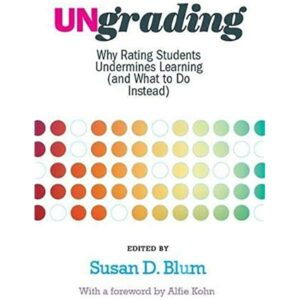
Ungrading Your Course: Radical Thoughts but Realistic Ways to Put the Emphasis Back on Learning
NIC Learning Session: Past Dates
~ Ungrading meaning: going gradeless, separating grades from feedback, rethinking grading, reducing marking, putting students more in control of their learning ~
Pre-pandemic and even more so during the pandemic, faculty are rethinking the ways they have traditionally been assessing and evaluating students. Ungrading – a perspective and practice – is about realistic ways to put the emphasis back on learning and decrease the heavy reliance on grades, marks, letters, numbers, values, rankings, and ratings as ways of communicating to students about their demonstrations of learning.
We are all familiar with this situation: students routinely skip over faculty comments and feedback on tests and assignments and instead focus on the mark or grade. Society gives great importance to rankings and ratings, grades and values. Post-secondary institutions are heavily invested in grades, transcripts, cut off marks, and admission standards – not something that can easily undone. So ungrading is just about moving the emphasis in the other direction during course learning – more on feedback and formative approaches to supporting student learning and less emphasis on grades, values, and marks.
Without awareness or understanding of the full scope of ‘ungrading’, immediate reaction from instructors is often characterized by statements such as the following. Honest responses and most often representative of the culture that has persisted in education for a few centuries.
- “Do you mean get rid of grades? We can’t do that. We have to submit grades at the end of the course. We can’t ungrade.”
- “My course outline indicates I am giving grades and my course is linked to other courses – so I can’t make a change.”
- “We have institutional policies and procedures around grading. We are not able to consider anything different than what we’ve submitted for approval.”
- “We aren’t doing our jobs if we aren’t grading and giving out marks? Students will demand to have a grade.”
- “Students need grades to know how they are doing in their courses. We can’t get rid of grades”.
- “My whole course has already been built around giving marks and percentages. It would be too much work to redo this to something different.”
An increasing collection of practices, discussions, Twitter posts, faculty stories, and student feedback has grown in the past five years. Change may take a few months and some thoughtful approaches, but students come around. They see the value in ungrading. They get it. They want it more. The faculty have their weekends back as marking decreases. In many courses, the de-emphasis of grades has created a more enjoyable teaching and learning experience, increased learning opportunities and more student engagement in the process.
Most often, the instructor still submits a final grade – but often in consultation with the student and framed around the some or all of the assignments/tests focusing on feedback and not grades. Many of these examples are collected together on this page under the names of educators who have changed their practices and shared their stories: Teach Anywhere > Practices and Pedagogies > Ungrading.
Ungrading is not a prescriptive set of processes you follow or one way to do it. Ungrading is not about removing feedback on student learning. Ungrading is not more work – and quite possibly less work. Ungrading is not contravening any institutional policy or process. Ungrading is what teaching and learning is all about – engaging learners in their learning journey. Ungrading is still rigorous and authentic. Ungrading is a humanistic perspective on teaching that focuses on enhancing student learning – not undermining and distracting students from learning.
In December 2020, a book collecting together some of the best pedagogies and practices was published and is a highly recommended read, “UNgrading: Why Rating Students Undermines Learning (and What To Do Instead) – $33.83“.
In the Fall of 2021, a ‘NIC Ungrading Community of Practice’ was formed. If you’d like to explore ungrading practices, start reading some of the faculty stories at: Teach Anywhere > Practices and Pedagogies > Ungrading

